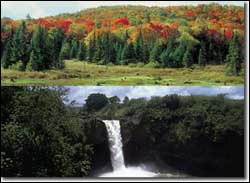While the rupture zones of recent major earthquakes are immune to similar-sized earthquakes for hundreds of years, they could be vulnerable to even bigger destructive temblors sooner than scientists suspect, according to analysis by University of Colorado seismologist Roger Bilham.
Bilham and his research colleagues explained that the magnitude 9.3 Indian Ocean earthquake of December 2004 showed scientists that a giant earthquake can rupture through a region with a recent histor
After some 400 years of relative stability, Earth’s North Magnetic Pole has moved nearly 1,100 kilometers out into the Arctic Ocean during the last century and at its present rate could move from northern Canada to Siberia within the next half-century.
If that happens, Alaska may be in danger of losing one of its most stunning natural phenomena – the Northern Lights.
But the surprisingly rapid movement of the magnetic pole doesn’t necessarily mean that our plane
New simulations of 21st-century climate show that human-produced changes in land cover could produce additional warming in the Amazon region comparable to that caused by greenhouse gases, while counteracting greenhouse warming by 25% to 50% in some midlatitude areas. The simulations from the National Center for Atmospheric Research (NCAR) show the importance of including land cover in computer-model depictions of global change. The results will be published in the December 9 issue of Science.
If humans continue to use fossil fuels in a business as usual manner for the next several centuries, the polar ice caps will be depleted, ocean sea levels will rise by seven meters and median air temperatures will soar 14.5 degrees warmer than current day.
These are the stunning results of climate and carbon cycle model simulations conducted by scientists at the Lawrence Livermore National Laboratory. By using a coupled climate and carbon cycle model to look at global climate and carbon
Surveys of three streams in the Russian River watershed show the first encouraging signs that a ground-breaking recovery effort is making headway rescuing coho salmon from the brink of extinction in part of its historic California range.
Recently completed snorkeling and electrofishing surveys estimate survival of more than 12,000 young fingerlings released last spring into Palmer, Sheephouse and Gray creeks at 54, 60 and 71 percent, respectively.
“We’re thrilled to see

Planting trees across the United States and Europe to absorb some of the carbon dioxide emitted by the burning of fossil fuels may just outweigh the positive effects of sequestering that CO².
New climate modeling research from LLNL and the Carnegie Institution shows that northern temperate forests (top) may contribute to global warming, while tropical forests (bottom) can help keep global temperatures cool. (Click here to download a high-resolution image.)
In theory, gro